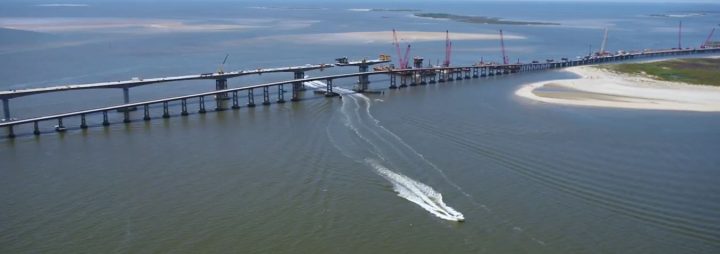
OUTER BANKS — It was not as long ago as it may feel to many Outer Banks residents, but it was indeed last century when planning for the replacement for the Herbert C. Bonner Bridge over Oregon Inlet began.
As the massive deck under construction dwarfs the adjacent 55-year-old span that will soon be gone, it may be a minor miracle that one of the most controversial bridges in North Carolina is on target to open by year’s end.
Supporter Spotlight
“All of the piles have been driven, work is continuing on the segmental portion of the bridge,” state Department of Transportation Division Engineer Jerry Jennings said in a recent interview. “The high-level portions heading south over open water is nearly completed.”
Taller, tougher and torturously delayed, the new 2.8-mile-long Bonner Bridge – the only land link between Hatteras Island and the central Outer Banks – is one of the more innovative spans in the state, and ultimately, one of its costliest and contentious projects. Yet, even after monumental battles over its design and location, it still crosses the most unruly inlet on the East Coast at the same place, and connects to the same portions of the most environmentally vulnerable barrier islands in the nation.
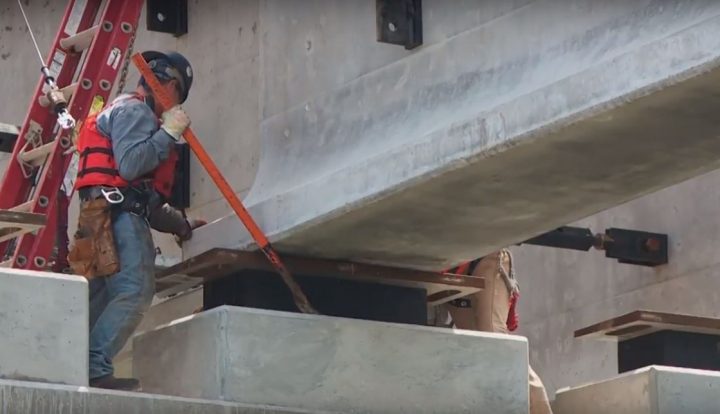
But now the bridge, 20 feet higher and a half-mile longer, is being built to last 100 years, twice what was originally planned, incorporating the latest technology and coastal science.
Jennings said that modeling had been done during the design phase to account for the maximum amount of scour at bridge pilings, which are significantly longer and deeper than those of the old bridge. The concrete is also stronger and reinforced with stainless steel rebar, making it much more durable in the harsh saltwater environment.
“Certainly for this part of the state, it involves a lot of construction methods and materials that we haven’t used on any other bridge,” Jennings said.
Supporter Spotlight
To the millions of people who have driven their vehicles over or steered their vessels under the old bridge every year, the much higher and longer navigational span of the new bridge will be most noticeable.
Instead of a single hump in the center, the new bridge will have seven, 300-foot spans, allowing vessels to follow best water rather than a fixed center channel. The higher deck, curved gracefully over the picturesque waterway, will provide an even more spectacular vista of Oregon Inlet, the only access from the sound to the ocean between Virginia and Hatteras Island.
And the new bridge will also have much safer 8-foot-wide bicycle lanes.
Partly due to a design adjustment that pulled the alignment on the south end of the bridge closer to N.C. 12 to minimize impacts, the replacement bridge cost has increased from $215 million when it was awarded in July 2011 to PCL Civil Constructers to the current cost of $250 million, Jennings said. About $19 million of the additional cost, he added, was owed to the contractor when the project was delayed by legal action.
Lawsuits, conflict and increasing coastal erosion have been the bane of the replacement project from the beginning, not to mention weather delays and unplanned problems.
According to the Army Corps of Engineers, in just the years the bridge was being planned, there were 95 hurricanes and tropical storms and numerous ocean overwash events experienced in the project area. And as recently as last summer, a huge crisis was created – although work didn’t stop – when PCL workers accidentally slashed a power transmission line to Hatteras and Ocracoke islands, cutting power for a week and forcing thousands of tourists to evacuate.
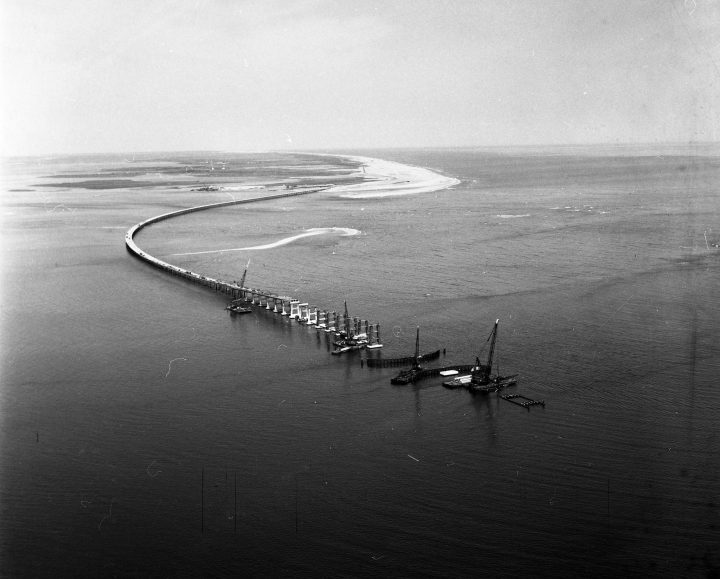
When the 2.5-mile Bonner Bridge was built in 1962, the price tag was about $4 million. By the time the bridge opened to traffic in Nov. 1963, the Corps had been dredging the inlet for three years to keep it navigable.
Since the day Oregon Inlet was slashed open by a hurricane in 1846, it has stubbornly and inexorably been moving south, and bridge engineers soon discovered that the waterway was not readily tamed.
According to an NCDOT document, the bridge was built with a curved alignment intended to protect the structure from the ocean’s fury during storms. Also, the bridge’s navigational span was situated under the assumption that twin jetties would be built within 10 years to stabilize the inlet. But the highly controversial jetty project never materialized.
“Since its construction, the bridge has required continual maintenance,” the agency lamented in the 1993 draft environmental impact statement for the $55 million proposed bridge replacement.
Within two years of being opened, severe scour was discovered around piles near the navigation span, according to the document, and the problem never really stopped. Between 1978 and 1992, for instance, the agency spent $9.3 million to correct scour issues, and has repeatedly – up until recently – had to take similar corrective measures.
The bridge has also been plagued over the years by corrosion and spalling, requiring numerous rehabilitation projects. By the time the bridge had passed its 25th birthday, NCDOT had spent close to $56 million on repairs.
In 1990, a $14 million terminal groin, or rock wall, was built perpendicular along the shoreline on the north end of Hatteras Island to control erosion of the roadway on bridge’s south entrance. Later that year, a huge dredge hit the bridge during a storm, demolishing several spans. It took nearly four months for the bridge to be repaired and reopened.
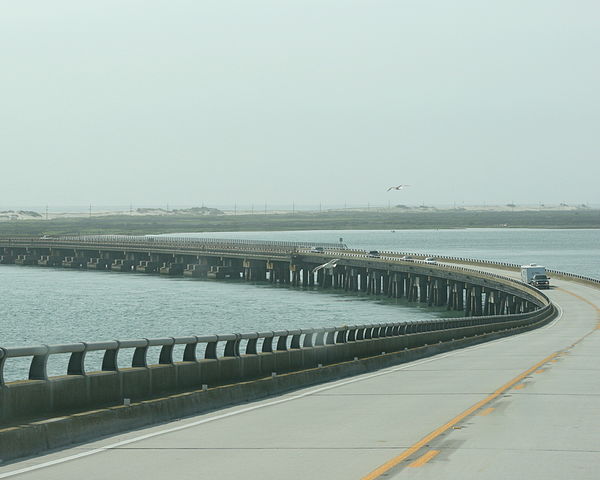
After work on the 1993 draft plan was shelved for years over issues with endangered species, planning for the replacement bridge was finally revived in 2002. The supplemental draft plan completed in September 2005 had expanded the study area south through Pea Island National Wildlife Refuge to Rodanthe. Subsequent bridge alternatives that included a $1 billion, 17-mile bridge that would bypass the refuge set off a firestorm and a series of lawsuits against NCDOT by environmental groups.
Anxiety about the bridge’s safety grew to alarm as year after year went by, way past its expected 30-year lifespan. In 2007, the bridge had a sufficiency rating of 2 out of 100, with 100 being the best.
A citizens’ group formed in Hatteras to urge construction of the new bridge, peppering lawmakers with letters and phone calls. Finally, after the lawsuits were settled in 2015, the replacement bridge was allowed to go forward, with groundbreaking on March 8, 2016. Meanwhile, under the terms of the legal agreement, smaller permanent bridges in Pea Island and in Rodanthe were also planned as part of Phase II of the project.
As requested by the Corps, the terminal groin and a portion of the existing bridge on the south end will remain. That infrastructure, the Corps said, will help to keep the inlet navigable after the old bridge is demolished. The expectation is that it would forestall Davis Slough from returning to the prevailing deep-water channel it had been before the old bridge was built.
“The existing Bonner Bridge substructure acts as a flow restrictor in Davis Slough and helps prevent the shifting of deep water channels within the inlet,” the Corps wrote to NCDOT in 2008.
Jennings said that discussions are ongoing with the National Marine Fisheries Service about the possibility of allowing people to fish on the remnant bridge. Catwalks on the south side of the bridge have long been popular fishing spots.
Meanwhile, mariners are expecting much easier and safer navigation in the inlet, notorious for its treacherous currents and shifting shoals.
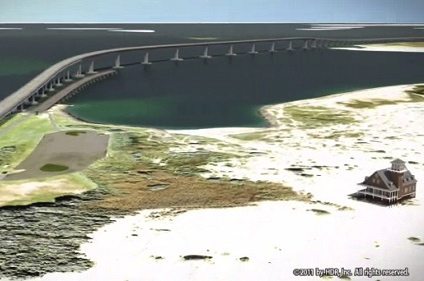
Joen Petersen is chief of floating plant with the Corps, which means he oversees floating cranes, debris boats, towboats, tugs, survey boats, dredges and other vessels related to navigation services. To Petersen, the changes will greatly improve the efficiency of his job dredging Oregon Inlet.
“It’s only going to get better at this point forward,” he said. “And we fully expect that there will be less – much less – dredging at the bridge.”
As a result, he said, the Corps won’t need to spend as much on dredging Oregon Inlet, and there will more time to concentrate on maintaining the ocean bar, where boaters enter the inlet. Also, the irksome spit on the north end that has often moved into the channel will no longer be an issue to mariners, thanks to the flexibility provided by more navigational spans.
Petersen said it’s still unknown how the inlet will respond once all the construction equipment is gone and the old bridge is demolished. But with all the larger openings under the bridge, it’s bound to be better for navigation, no matter where the prevailing deep water wants to be.
“I am ecstatic about it,” he said. “I am very, very hopeful.”









